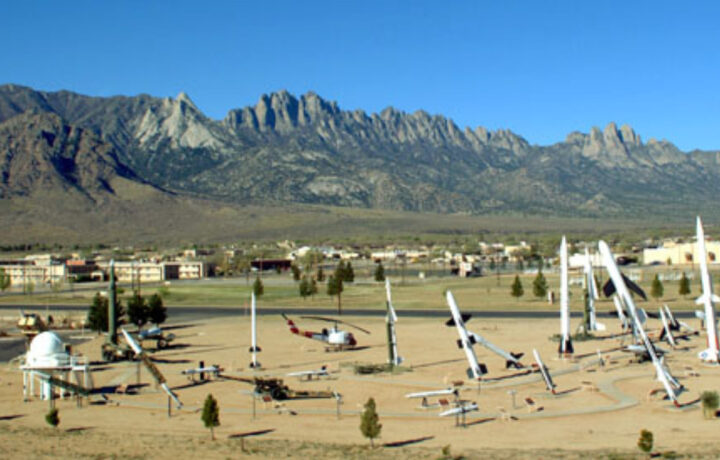The United States Air Force Life Cycle Management Center and Raytheon Technologies announced the first successful test of the Air Force’s first palletized high-energy laser weapon. The tests were conducted during four days of continuous live-fire exercises at White Sands Missile Range in New Mexico.
The defense contractor explained that the new palletized laser weapon was the first 10-kilowatt laser built to U.S. military specifications in a stand-alone configuration that could allow it to be moved and mounted anywhere it’s needed. The palletized laser weapon system was built in the world’s first laser weapon factory in McKinney, TX, and delivered to the Life Cycle Management Center nine months after receipt of the order.
H4 On Target
Known as “H4,” the palletized laser weapon was developed to protect people and assets against short-range aerial threats. It has passed the Air Force’s Test and Assessment plan, which included multiple days of live-fire exercises to acquire, target, track, and destroy drone targets in short-range attack, swarm attack, and long-range threat scenarios.
The H4 is the fourth operational laser weapon system that Raytheon Technologies has delivered to the United States Air Force. It is also the eighth total system the company has delivered to the U.S. Department of Defense (DoD)
“Anywhere the Air Force sees a threat from drones, they now have four proven laser weapons that can be deployed to stop asymmetrical threats,” said Michael Hofle, senior director of High-Energy Lasers at Raytheon Technologies. “Whether it’s on a fixed location, a flatbed or even a pickup, these laser weapons are compact, rugged and ready to go. That’s why we’re proud to support the Air Force’s effort to provide this new tech to the personnel who need it in the field, who can trust and be confident in the system’s capabilities.”
According to Raytheon, the H4 is small enough to fit in the bed of a pickup truck. The laser weapon system comprises a high-energy laser weapon module, a long-range EO/IR sensor that also serves as the beam director, thermal control, internal electrical power, and targeting software – all packaged together for use in the toughest combat environments. It can be operated with a laptop and a video game-style controller, and it can reportedly be employed in a number of existing air defense, and command and control systems to provide a needed layer of defense.
Ray Guns: From Fantasy to Reality
Long before Raytheon Technologies developed the H4, the concept of laser-like weapons existed in science fiction. Writers such as H. G. Wells and Jules Verne first wrote about such “death ray” weapons more than a century ago, but it wasn’t until the 1930s that British Air Ministry considered whether such a platform could be even developed. Work was first undertaken by Robert Watson-Watt of the Radio Research Station, and while he and colleague Arnold Wilkins concluded such a project wasn’t feasible, it did result in the development of radar.
Though it still seems that future wars won’t be fought with handheld “laser guns,” Raytheon is far from alone in developing “directed-energy weapons” (DEWs). The use of directed energy would be a serious force multiplier, which is why so much emphasis has been placed on its development. These have included efforts in High Power Microwave (HPM) and High Energy Laser (HEL) systems.
Large Investments
According to a late 2021 report from research firm GlobalData, DEWs have matured quickly and were close to transitioning towards widespread, practical, and cost-effective field development. As DEWs are successfully developed and deployed, the platforms could have an immense potential to be revolutionary in the long term.
The analyst firm reported that in just the past two decades, military use of DEWs has also moved from the research laboratory to the operational force, and lasers have become a highly effective instrument for military operations. The United States currently had led in the development of DEWs worldwide and had doubled its spending on the technology from fiscal year (FY) 2017 to FY19 – from $535 million to $1.1 billion.
Other countries including China, India and Russia are also investing in the development of DEWs, even as many regional powers have not shown the same level of zeal for the technology.
U.S. Navy DEW Efforts
The U.S. Air Force hasn’t been alone in seeking to develop DEWs. The U.S. Navy has been working for more than a decade on various efforts to equip warships with laser weapons that could confuse or destroy enemy systems. The service’s fiscal year 2023 (FY23) budget request had called for more than $103 million to support half a dozen laser weapon concepts.
It was last August that Lockheed Martin announced it had delivered to the U.S. Navy a 60+ kW-class high-energy laser with integrated optical dazzler and surveillance (HELIOS). It was the first tactical laser weapon system to be incorporated into existing ships and provides directed energy capability to the fleet.
Reported to be integrated and scalable by design, the multi-mission HELIOS system will reportedly be able to provide tactically relevant laser weapon system warfighting capability as a key element of layered defense architecture. The HELIOS system could further support long-range intelligence, surveillance, and reconnaissance (ISR) missions.
Lockheed Martin was awarded the Surface Navy Laser Weapon System (SNLWS) Increment 1, known as HELIOS, contract in January 2018 and has made steady progress on this rapid Directed Energy prototype.
One of the clear benefits of lasers and other DEWs is its pricetag. Rather than expending missiles that cost anywhere from tens of thousands to millions of dollars each to manufacture, a laser depends only on electrical output, which can be generated for less than $1 per shot.




